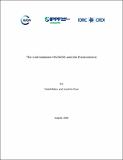| dc.description.abstract | Executive Summary
It is estimated that 1.5 million people have died of HIV -related illnesses in Kenya
since the first case was diagnosed in 1984. A total of 1.8 million children have been
left orphans, and 1.4 million people are currently living with the disease. The high
level of dependence of the majority o f Kenyans on natural resources means that they
have turned to these same resources for solutions in the management of HIV/AIDS.
This has therefore put additional pressure on the natural resource base.
The study found that there are both direct and indirect linkages between HIV/AIDS
and the environment/natural resources. Factors in the environment can either
enhance or inhibit the spread of HIV. Malaria, that is endemic in some parts of
Kenya, increases the transmission of HIV as do many sexually transmitted diseases.
The study also shows that herbal medicine is widely used and reduces the risk of
infection when used for sexually transmitted infections and febrile illnesses such as
malaria. The herbs also slow down disease progre ssion when used to treat
opportunistic infections. The same herbs can, however, lead to accelerated disease
progression if not used properly such as when used in combination with ARVs or
when preferred to ARVs. Unfortunately, the increased demand for herba l remedies is
resulting in their over-exploitation and the threat of their extinction. Similarly, there
has been an increased use of wild foods and timber due to the pandemic.
Progression of disease is also accelerated by poor hygiene and sanitation which
leads to the spread of infectious diseases among PLHIV. Poor disposal of HIV
contaminated materials, such as condoms, syringes and home -based care kits poses
a threat to communities, especially in the informal settlements in Kenya’s urban
areas.
The indirect linkages between HIV/AIDS and natural resources include the fact that
areas with abundant natural resources tend to attract many people, including those
who are running away from stigma due to their HIV status. The key sectors of
fisheries, commercial agriculture and tourism tend to create conditions that make
people more likely to get infected with the virus. Factors such as mobility, availability
of cash and lack of social inhibitions due to distance from family in these sectors
contribute to the spread of HIV.
The HIV/AIDS pandemic has also had an impact on the land tenure systems of
communities, while at the same time; some of the existing land tenure systems have
put more people at risk of contracting HIV. When productive members of the
household have passed on, the remaining members may lease the land or leave it
fallow. Further, following the death of men from HIV, their widows are sometimes
denied their rights to inherit the land and may be forced from the marital home. The
sub-division of group ranches, and the subsequent sale of land that is registered
under private title, has also contributed to the spread of HIV, as irresponsible land
owners have used the money for alcohol and commercial sex.
The impacts of HIV/AIDS on conservation have included the loss of staff and loss of
the investment of training them, the cost of meeting medical bills and the cost of
recruiting new staff. At the community level, the pandemic makes it difficult for
agencies attempting to promote community conservation initiatives to do so, due to
the heavy demands on the communities’ time to attend to the sick and bury the dead.
In some cases, conservation efforts have put communities at risk of contracting HIV,
such as when they have been evicted from forests and other conservation areas that
previously served as their homes and sources of livelihood.
Kenya HIV/AIDS and Environment Study
5
Rural-urban migration is sometimes prompted by the limited options available for
rural communities to eke out a living from a degraded environment with poor soils
due to over cultivation and grazing. People who travel to urban areas in search of
employment are placed at risk of infection, which then makes them conduits through
which the virus is introduced to the members of the community in their rural homes.
Some of the existing initiatives to address issues arising from the linkages between
HIV/AIDS and natural resources include projects to generate knowledge and share it
with others. Several organizations and networks are involved in this, such as the
African Biodiversity Collaborative Group (ABCG), the Population Reference Bureau
(PRP), the Food and Agriculture Organization (FAO), the Swedish International
Development Agency (SIDA), the Southern Africa Development Community (SADC)
and the Coastal Resources Centre (CRC). These organizations have conducted
surveys and produced research papers, toolkits and guidelines, aimed at addressing
different issues related to HIV and NRM.
Other initiatives are focused on tackling specific emerging issues, by assisting
communities to develop more effective coping mechanisms. These include initiatives
that target high risk groups within high risk sectors, by educating them on the risks
and providing them with sustainable options for using natural resources to address
their livelihood needs.
At the organizational, national and international levels, policies are being formulated
to tackle the HIV/AIDS issue and mainstream effective responses within different
sectors, such as forestry, conservation, fisheries and land.
Due to the complexity of the HIV/AIDS pandemic, with regard to the social and
economic factors that contribute to its spread, it is important that a multi-sectoral
approach is adopted when tackling specific concerns.
It is therefore important to draw lessons from those communities and countries that
have had success in different aspects of the issue, and up-scale and replicate these
initiatives after analysing how they should be modified to suit the different social and
cultural contexts. | en_US |

